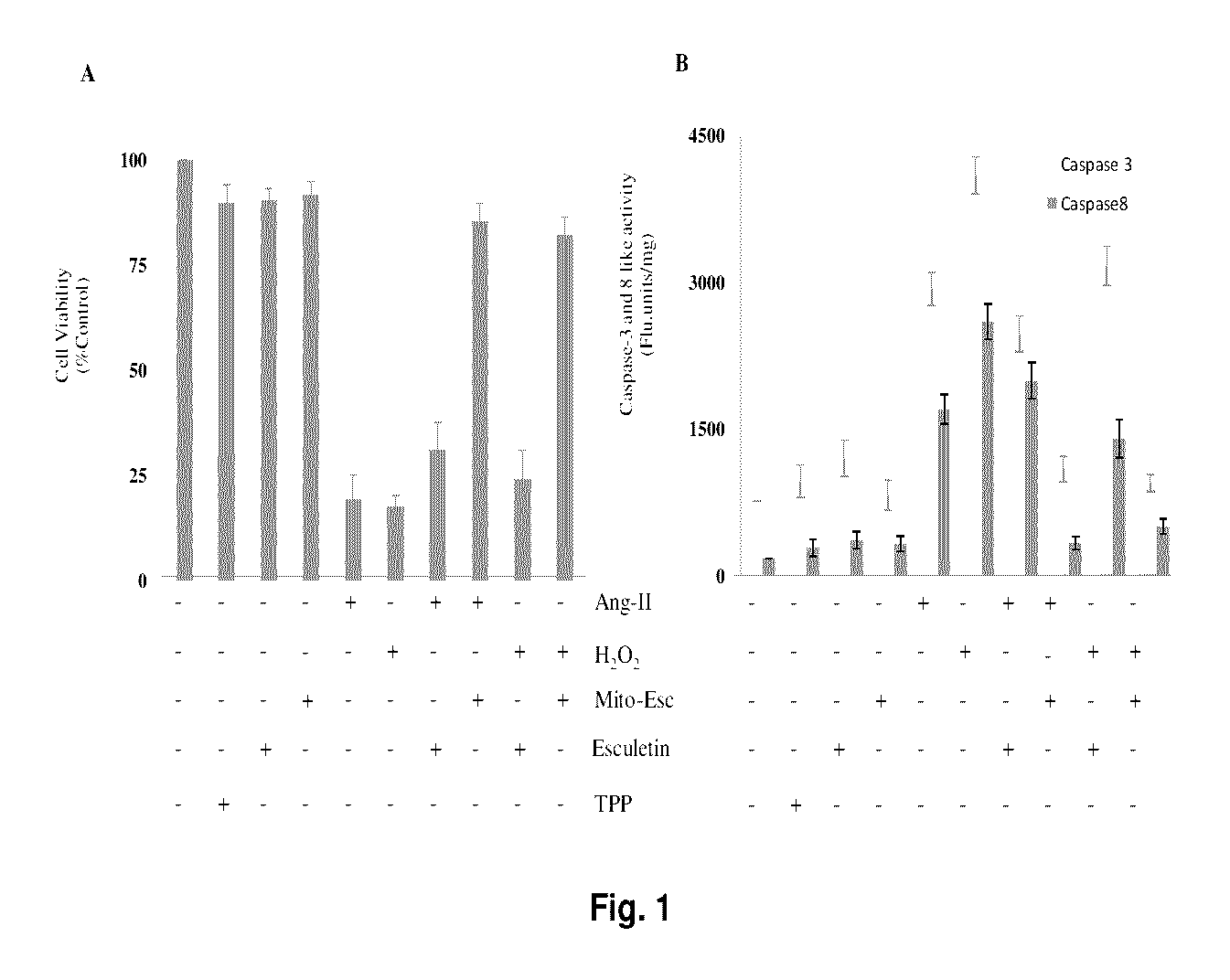Antioxidant compound having anti atherosclerotic effect and preparation thereof
an anti-atherosclerosis and anti-oxidant compound technology, applied in the direction of phosphorous compound active ingredients, group 5/15 element organic compounds, drug compositions, etc., can solve the problems of endothelial dysfunction, plaque formation, mitochondrial disease treatment, etc., to reduce h2o2-induced endothelial cell aging, attenuate ang-ii-induced atherosclerosis, and increase phosphorylation
- Summary
- Abstract
- Description
- Claims
- Application Information
AI Technical Summary
Benefits of technology
Problems solved by technology
Method used
Image
Examples
example 1
Mitochondria-Targeted Esculetin (Mito-Esc) but not Native Esculetin Abrogates Oxidant-Induced Cell Death in Human Aortic Endothelial Cells (HAEC)
[0043]We have studied the effects of mitochondria-targeted esculetin (Mito-Esc) (2.5 μM) as well as the native esculetin (2.5 μM) on Ang-II (500 nM) and H2O2 (500 μM)-induced endothelial cell death. For this, cells were pretreated for 2 h with either Mito-Esc or esculetin before they were incubated with either H2O2 or Ang-II. Mito-Esc but not esculetin significantly inhibited oxidant (H2O2 and Ang-II)-induced endothelial cell death (FIG. 1C). However, TPP+ alone did not have any appreciable cytotoxic / cytoprotective effect in HAEC (FIG. 2C). Thereby, indicating that the observed protective effect of Mito-Esc is not because of the TPP+ side chain coupled to esculetin. Next, to confirm that H2O2 and Ang-II caused an apoptotic mediated cell death in HAEC, we measured caspase-3 and -8 activities in cells treated with same conditions as shown in ...
example 2
Mito-Esc Decomposes Ang-II-Induced H2O2 Generation and Preserves Oxidant Mediated Depolarization of Mitochondrial Membrane Potential
[0044]Ang-II is known to increase oxidative stress through increased production of H2O2 (Doughan A K, Harrison D G, Dikalov S I. Circ Res (2008) 102:488-96). To see the effect of Mito-Esc in regulating Ang-II-induced H2O2 production in endothelial cells, HAEC were treated with Ang-II (500 nM) in the presence or absence of Mito-Esc (2.5 μM) for a period of 16 h and H2O2 production was measured by Amplex red assay. In cells treated with Ang-II, H2O2 generation was significantly increased by around 2.7 fold compared to untreated conditions (FIG. 2A). Interestingly, Mito-Esc co-treatment completely reversed H2O2 levels to control conditions (FIG. 3A). Thereby suggesting that Ang-II-induced cytotoxicity in HAEC involves oxidative stress and that co-incubation of HAEC with mito-Esc greatly attenuates Ang-II-mediated cell death by decomposing H2O2 levels. Furt...
example 3
Mito-Esc Potentiates Nitric Oxide Generation Via Increased eNOS Phosphorylation in HAEC: Effect of NOS Inhibitor on Mito-Esc-Mediated Inhibition of Oxidant Mediated Cell Death
[0045]To gain mechanistic insight on Mito-Esc-mediated protection of endothelial cells from oxidant-induced endothelial cell death, initially we hypothesized that Mito-Esc may augment intracellular nitric oxide generation. To study this, HAEC were treated with both Mito-Esc and esculetin in the presence or absence of H2O2 for a period of 4 h and nitric oxide (NO) levels were monitored by DAF-2 derived green fluorescence. Previously, it has been shown that DAF-2 forms a fluorescent triazole-type product in the presence of an oxidant derived from nitric oxide and oxygen interaction (Proc. Natl. Acad. Sci. USA 99: 11127-11132; 2002; Am. J. Physiol. Regul. Integ. Comp. Physiol. 286:R344-R431; 2004). Intriguingly, Mito-Esc alone but not native esculetin greatly enhanced the DAF-2 fluorescence in HAEC (FIGS. 4A and 4...
PUM
| Property | Measurement | Unit |
|---|---|---|
| membrane potential | aaaaa | aaaaa |
| temperature | aaaaa | aaaaa |
| temperature | aaaaa | aaaaa |
Abstract
Description
Claims
Application Information
 Login to View More
Login to View More - R&D
- Intellectual Property
- Life Sciences
- Materials
- Tech Scout
- Unparalleled Data Quality
- Higher Quality Content
- 60% Fewer Hallucinations
Browse by: Latest US Patents, China's latest patents, Technical Efficacy Thesaurus, Application Domain, Technology Topic, Popular Technical Reports.
© 2025 PatSnap. All rights reserved.Legal|Privacy policy|Modern Slavery Act Transparency Statement|Sitemap|About US| Contact US: help@patsnap.com



